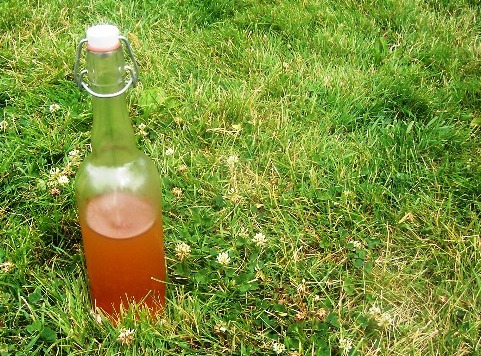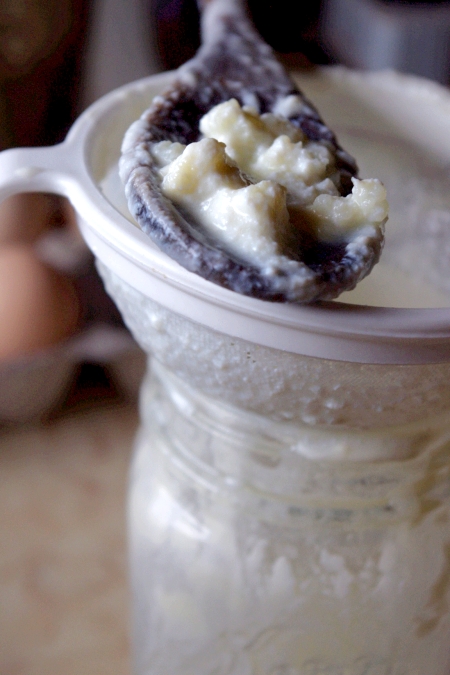Fermented Foods for Beginners: Kombucha
 This is the final part of a series on fermented foods for beginners. You can find the first three parts here:
This is the final part of a series on fermented foods for beginners. You can find the first three parts here:
- Part 1: Introduction
- Part 2: Fermented Dairy
- Part 3: Lacto-Fermented Vegetables
The first time I tasted kombucha it came from a bottle that I purchased for over $3 at the whole foods market. I had just read about it in Nourishing Traditions and in my zeal to make some major dietary changes I splurged. When I opened up I noticed bubbles, similar to what you would find in soda pop. So, being that I was totally unprepared for the intense flavor of kombucha, I took a big swig. I nearly choked due to the carbonation and acidity. After a few more sips I was hooked.I find that Kombucha tastes a bit like a tart sparkling wine.
Since then I have purchased a bottle here and there as a treat, but at $3.50/bottle there was no way I could drink a glass per day. So about 6 months ago I finally took the plunge and started researching how to make my own. It turns out that once you get a scoby (stands for symbiotic culture of bacteria and yeast) the process is quite simple and hands off. Basically kombucha is a fermented sweet tea.
Health Benefits
There are many health claims regarding kombucha. Like other fermented foods it contains living bacteria, which are said to aid in digestion and help ward off candida. It is also said to aid in cleansing the liver (source). On a personal note I have noticed an improvement in digestion and energy since I have started drinking it on a regular basis.
How to Make It
Kombucha is fairly easy to make. Here is the general method:
- First off do not use any metal jars or utensils for the process. I use large glass jars and a wooden spoon for stirring in the sugar.
- You can either obtain a scoby along with a small amount of kombucha from a premade batch or grow your own from a bottle of raw organic kombucha.
- Brew up some sweetened black tea. As a sidenote I have read that organic teas will not contain fluoride as some non-organic teas. You will use 2 tea bags and 1/4 cup sugar per quart. It is recommended that you use white sugar for the tea. It is said that the bacteria eat up the sugars in the tea if you allow it to ferment long enough, so no need to worry.
- Allow tea to cool to room temperature and add your scoby (“mother”) and premade kombucha to the sweetened brewed tea.
- Cover loosely with cheesecloth, a tea towel or a light cloth napkin and bind with a rubber band.
- Allow to ferment in a dark, warm place for at least 5-7 days. After the first 5 days you can taste it, but keep in mind that the longer you let it sit the less sugar it will contain. Because I am trying to avoid sugar I let it ferment for at least 2 weeks.
- Once the tea has reached your desired level of fermentation, remove the original scoby and the newly formed “baby” scoby. You can now use these scobys to make more than one batch of fresh kombucha.
- Place an air-tight lid on your jar or transfer to smaller jars and cap. At this point you can refrigerate and allow to become more carbonated over time or do a 2nd fermentation using fruit juice.
- I find it most delicious when it has sat in the refrigerator for several days.
Where To Find Starters
If you are a bit apprehensive or unfamiliar with the culturing process you may want to consider purchasing a scoby that will come with detailed instructions. I found that these instructions were very thorough, easy to follow and took away a bit of the apprehension. You can find kombucha starters on my resources page here. Happy brewing!
What about you… have you tried kombucha? Do you brew your own and if so what method do you use?


I actually started one a few days ago! I just need to find those cool bottles like the one you have pictured! =)
I started making it about 9 months ago. I got a scoby from a local internet friend, and I use an old water crock, with a spigot. Found those EZ-cap bottles at a local beer-brewing supply store.
Have you tried flavoring yours? Put a couple of frozen raspberries in a bottle and let it sit for a day or two. Yummy!
I just started another batch last night. I had to remake my scoby from some store bought. I’m always striving for the fizziest kombucha I can make. I still haven’t figured out the secret to the fizz.
I also do a double ferment using some organic grape juice concentrate. I saved a lot of the GT kombucha bottles and that is what I use for my bottling.
How much fruit juice would I use to ferment this a second time???
I can’t wait to try making it myself. I prefer the added fruit juice flavors to the original taste.
Thanks for the inspiration! I made kombucha for a while and never had any issues — always quite straightforward. Just composted my mother since I wasn’t drinking/making it (lazy).
I read another post today from someone who makes grape flavored (1/4 c./batch) (maybe this answers your question @Helen?)
http://smallnotebook.org/2009/07/27/how-to-make-kombucha-tea/
Yippee! I made kombucha about 14 years ago for my husband, and then it just kinda went away. Rediscovered it when I purchased Nourishing Traditions, and have been waiting for a scoby from a friend of mine – haven’t purchased ANY tea at all. But tomorrow I’m going to get a bottle of raw organic kombucha from my health food store and start my own. I’m so ecstatic! Thanks.
how dark does the dark place have to be? The reason why I ask is that it seems that my only dark places are closets – and those are opened from time to time. Will this be a problem?
Do you think I could put this in my food dyhdrator and keep the door shut, is that dark enough????
I’m brewing kombucha again, but I don’t go through it very quickly so I’m not going too gung ho with it. I would love to have some ideas for the secondary fermentation and how to achieve fizz. I have flip top bottles for beer brewing so I am going to try that with some ginger, which I hear really helps with the fizz. Good kombucha is so, so good!
I’ve been making Kombucha for over a year now weekly. I have several links at my site on my process of it. Anyone can just type in Kombucha in the search button and it will bring to several postings. I have slide show, and various other postings.
Enjoying your site and have added it to my blog links.
I have a question about making kombucha? should the kombucha be carbonated after the first fermentation, or does it carbonate after it is bottled into smaller jars? Thank you.
oh, another person today that mention the book Nourishing Traditions. definitely going to be going to barnes and nobles today to purchase this book. never had a kombucha before but i’m going to the whole food market to get a bottle today. going to give it a try. thanks for the blog posT!
Well here’s what I’ve been doing and the fizz seems to increase over time.
I started my batch the usual way…sweet tea, bottle of store bought kombucha, glass container covered with cloth and hair band to keep it on there…
a few weeks later I noticed it starting to skunk a bit and I attributed this to my living bacteria dying from starvation…the solution?
MORE SUGAR. Bzing!
a week later my kombucha was fresher than ever and started to increase in fizziness.
It’s a living batch. Remember this and it needs to be fed like a goldfish. So I just keep mixing up my sweet tea or even buying a jug of Arizona and dumping that in. (I have a 5 gallon wine making jug, so there’s much room for blending different liquids)
My next step is grape juice. I want to develop a sort of Kombucha Wine. I think if I let it ferment long enough it will come out a potent, living wine.
All good things. Just be sure to feed your culture. Simple as that. Within 5 days or so the sugar content is greatly reduced. I’d say about a week or two is about as long as it will go before needing to be fed.
Enjoy your new pet culture and happy brewing 😉
-Hack
Ps. I find that total darkness increases the skunk potential. I keep mine in the garage where it’s either dark or low light. But it does get fresh air and some light, not direct but residual. I think the good bacteria are able to overpower any bad that may come from the fresh air…but remember this is an old world beverage and perfect sanitation was certainly not an option in those days.
living wines – Could you explain what you mean by skunky? And thanks for all the tips!
Yes- skunky: going bad, smelling foul or rotten
Just a helpful suggestion – go back to parts 1, 2 and 3 and link those as well. The only post you have all four parts linked is the last one and it made it hard to find them all. Thank you for your very helpful info. I will be starting with fermented foods!
Could you explain why you shouldn’t use metal utensils? I had a friend generously offered me a Scoby and right in front of me used a fork.
Does that mean it is no good now ? ?
Hi! I have been tryiing to make kombucha for about a year, and i can not get it to fizz. so i found your website and am starting again. BUT….I just boiled my water and brewed my tea in a metal sauce pan. Does that mean i can’t use it?? And how do I brew tea, if I don’t use a pan on the stove? (Maybe a silly question)